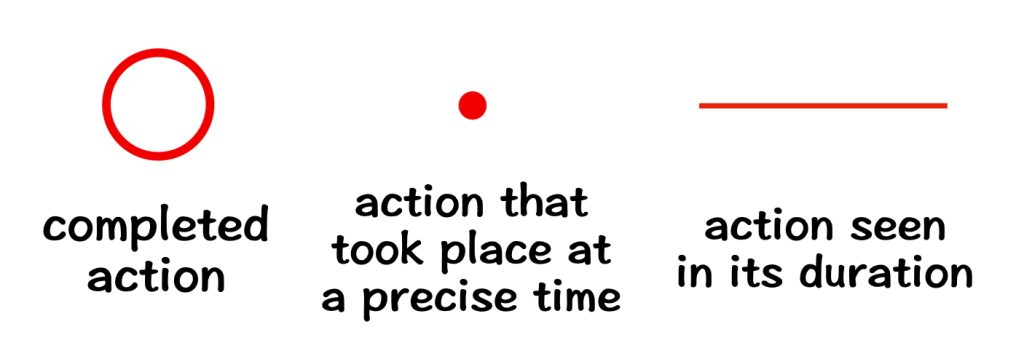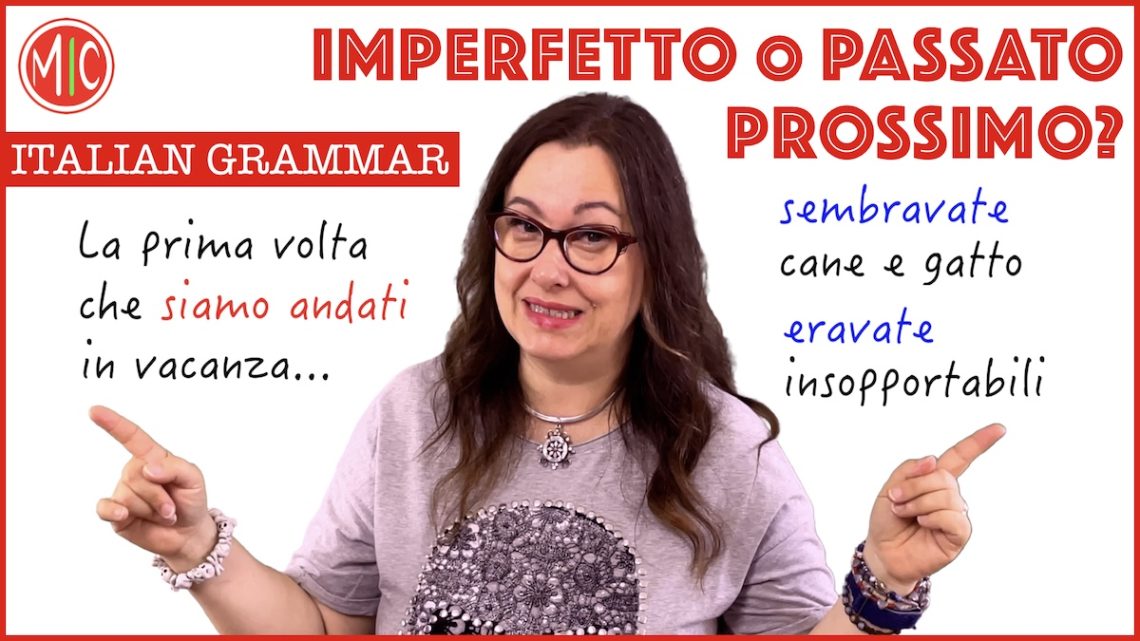
Italian has several past tenses, but the passato prossimo and the imperfetto are the two most common ones. The imperfetto does not exist in English, but it can be translated using the past simple or the past continuous. The passato prossimo is a compound tense, similar to the English present perfect, but it can also be translated with the past simple. How do we choose between one or the other?
What is the difference?
To understand the nature of these tenses, let us consider three shapes: a circle, a point, a line. We can associate a completed action to a circle, an action that took place at a precise moment to a point, and an action seen in its duration to a line.

In Italian, a completed action corresponds to the passato prossimo:
- Ho guardato questo video tre volte. I have watched this video three times.
Here I underline the completed nature of the action; I don’t care when exactly I watched the video, or what happened while I was watching it, I care about the fact that the action was completed: a circle.
The passato prossimo is also used to describe an action that took place at a specific time: a point.
- Ieri ho guardato il video che mi hai consigliato. Yesterday I watched the video you recommended.
The passato prossimo corresponds to a circle: action completed, in general; or to a point: action completed at a specific time.
What is the imperfetto?
What about the imperfetto? This tense is imperfect, unfinished, not because the actions it describes are incomplete, but because we are interested in their duration, not in their completion. The imperfetto describes a state, a situation, an action seen in its duration: a line. We don’t care when the action began or when it ended, we are interested in the fact that the action or the state lasted for some time:
- Ieri non volevo parlare con nessuno. Yesterday I didn’t want to talk to anyone. —> Probably for the entire day.
The imperfetto is also used to talk about a past habit, a habitual, repeated action in the past, like the English “used to“:
- Da piccolo andavo al mare ogni anno. As a child I used to go to the seaside every year. —> Ogni anno, spesso, sempre are often used in this kind of sentences.
If we talk about actions that we did once or more than once, but which are not habits, we use the passato prossimo, instead:
- Sono stato a Roma due volte. I went to Rome twice. —> I went and came back: completed actions.
Instead, we use the imperfetto to talk about a state or a continuous action in the past:
- Nel 2010 vivevo a Roma. I was living in Rome in 2010. —> Past continuous.
- Ieri ero di cattivo umore. Yesterday I was in a bad mood. —> My bad mood lasted for some time.
Can we use both tenses in the same sentence? Yes, if we have an action that interrupted another one, for example:
- Mentre dormivo ho sentito un rumore improvviso. While I was sleeping I heard a sudden noise. —> Imperfetto for the continuous action of sleeping, passato prossimo for the sudden noise.
When talking about the past, the conjunction mentre, while, is always used with the imperfetto. Quando, when, can use both:
- Quando ero all’università sono andato in Cina. When I was at university I went to China. —> I went to China while I was at university.
- Quando mi sono laureato sono andato in Cina. When I graduated I went to China. —> First I graduated, then I went to China.
Another use of the imperfetto that is becoming increasingly common is the imperfetto ipotetico. Here the imperfetto is used in a conditional sentence instead of more complex compound tenses:
- Se lo sapevo, non venivo.
In standard Italian, this sentence would be:
- Se lo avessi saputo (congiuntivo trapassato), non sarei venuto (condizionale passato). If I had known it, I wouldn’t have come.
Conclusion – When to use the imperfetto
This is just the tip of the iceberg, but it should give you a sense of the difference between imperfetto and passato prossimo. The imperfetto is a powerful tense that we use a lot in conversation, so it’s important to keep it in mind as an option when you need to talk about the past.
Use the imperfetto to describe people, places or situations in the past; to talk about a state of mind or a physical state in the past; to describe things you used to do or that you did for some time; to talk about actions that took place at an unspecified time, or something that was going on when something else happened.
Ask me questions in the comments if you have any, and watch our video lessons on these tenses for more examples and exercises.
A presto!
Anna
We also discuss the choice between imperfetto and passato prossimo, in more detail and using different examples, on Daily Italian Words.
Related video lessons:






